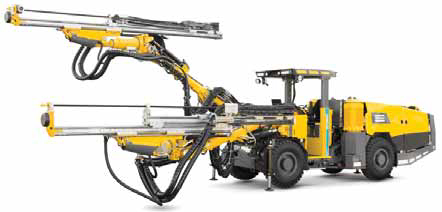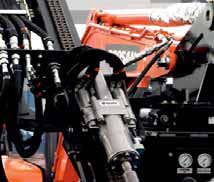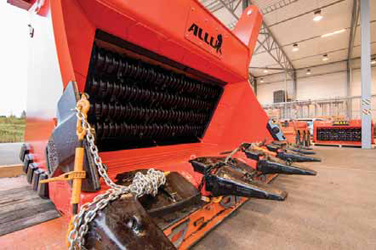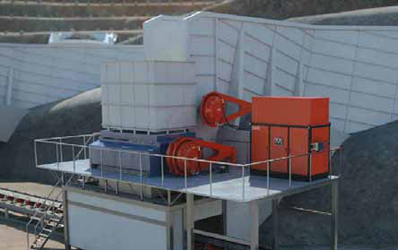
Using a ‘quick charge’ station, Sandvik LH307B can be ready for use in approximately 15 minutes
Nordic Mining Technology
Suppliers unveil autonomous, emissions-free equipment for miners and new
technology for processing plants
By Steve Fiscor, Editor-in-Chief

What sets these suppliers apart is their experience and appreciation of the cyclic nature of the mining business. During good times and bad, they are committed to advancing the industry and supporting the miners who are confronted with lower metals prices and rising costs and an increasing regulatory burden.
As an example, Sandvik has been developing automation solutions for mines for more than a decade. An underground mine in Australia recently became the first 100% automated underground operation using the systems it developed. The supplier’s rich history of developing solutions by working together with customers and looking at their everyday needs has led to a scalable automation offering, and its installed base of automated equipment continues to grow. “There is a marked increase in interest and activity surrounding automation,” said Patrick Murphy, president, Rock Drills and Technologies, for Sandvik Mining and Rock Technology. “Our products have logged millions of safe, productive hours of automated operation in underground applications, and these include the first self-driving loaders and underground trucks in the world. Those systems were commissioned more than 10 years ago, so it follows that we also have the most experienced team in the business.”
With the connectivity and digitalization of everything continuing to advance at a rapid pace, great possibilities are opening up. “We have the ability to measure more on our equipment than we ever have before, but the key question our customers are asking is: ‘How do we get actionable insights from this data?’ When we combine the onboard data with other data sets available from our customers’ processes, we can, in fact, get amazing insights to help our customers immediately improve their operations,” Murphy said. “This is an area in which we are investing considerable effort and we expect new products to be launched around the data-driven productivity theme in 2017.”
There is no science fiction about this, Murphy explained. Miners will continue to see more solutions designed to increase their productivity, reduce total costs of ownership, and ensure reliability, efficiency and safety through high technology.
Sandvik Goes Emissions Free
Mining companies and suppliers constantly
strive to develop responsible
mining practices with safe and cost-effective
production. One initiative in this
quest is to reduce the use of diesel-powered
equipment underground, which has
a positive impact on the health of the
miners, reduces ventilation costs and improves
the environment.
Prior to MINExpo, Sandvik announced that Goldcorp had opted to use some of its equipment for its Borden Lake project, which is planned as an all-electric underground gold mine (See Suppliers Report, p. 71). “We can provide a full solution for development equipment for the mine because of our breadth of offering,” said Dale Rakochy, business line manager, underground equipment, Sandvik. “It’s a fully integrated battery technology where you don’t have to remove, handle or swap batteries underground, providing improved safety for operators and maintenance crews.”
One of the equipment models already ordered for this project is the Sandvik DD422iE, a battery-trammed jumbo, which was on display at MINExpo 2016 in Las Vegas. The DD422iE generates zero emissions while maneuvering between headings. This improves health and safety for miners working underground. Less diesel usage in a mine thanks to diesel-free drilling can ease ventilation requirements, while also reducing associated diesel logistics and maintenance expenses. Using the mine’s existing electric infrastructure, the Sandvik driveline technology enables the battery to recharge during the drilling cycle. The battery will even recharge while Sandvik DD422iE is tramming downhill, using energy generated by the braking system. The long-lasting pack will power the drill efficiently throughout its lifetime.
Sandvik also introduced a batterypowered loader, the 6.7-metric-ton payload LH307B. The battery-powered LHD has the same level of independence as diesel-powered LHDs without the related diesel emissions and costs. Using a “quick charge” station, the LHD can be ready for use in approximately 15 minutes. Its lithium titanate oxide (LTO) battery technology enables rapid recharging, providing continuous operation with a single battery pack— there is no need to swap batteries during or between shifts. Sandvik said liquid cooling guarantees a long battery life across a broad range of ambient temperatures.
Atlas Copco Focuses on Automation
Discussing the potential impact of today’s
innovations, Johan Halling, president of
Atlas Copco’s Mining and Rock Excavation
Business Area, said he is optimistic
about the future of mining. “The global
mining industry has experienced downtrends
before, and each time it has managed
to bounce back and become even
stronger, largely thanks to the development
of innovative products and new
thinking,” Halling said. “I am certain that
the current downtrend is no exception.”

He also explained that Atlas Copco’s mission is not just to develop solutions that increase productivity and cut costs, but to also provide solutions that are environmentally sustainable as well. “We believe that this combination is the right formula for long-term success and makes us an ideal partner for future growth and prosperity,” Halling said.
The recent advances made by Atlas Copco in automation are considerable and some have been described as game-changers for the industry. A prime example is the recently released Boomer S2 drill rig. It is the first automated drill in the small face drilling segment. According to Atlas Copco, no other rig in this class can match its productivity at such low operational cost. The rig is said to work harder and longer with strengthened components and increased parts protection resulting in minimal internal wear, faster drilling and overall durability. The Boomer S2’s COP MD20 rock drill is said to be 10% faster in blast and bolt hole drilling than comparable rock drills on the market, while at the same time Atlas Copco’s dampening technology improves drill steel economy and increases drill uptime. A new, intuitive interface, upgraded software, automated add-ons and user-friendly environment add up to safer, more productive rock drilling.
For open-pit mining, Atlas Copco also debuted a fully autonomous, cabless Pit Viper 275 blasthole drill at MINExpo. Known as the PV-275 CA (C=cabless and A=autonomous) for now, the drill included the full suite of Atlas Copco products required to run an autonomous drill. While it was designed and built as a concept for the MINExpo show, it was fully operational and the technology on display is identical to the technology that Atlas Copco has been using for years on semi- and fully autonomous drills. The heart of the autonomous Pit Viper is the Rig Control System (RCS) launched first by Atlas Copco over a decade ago. This CAN-bus system provides the building blocks for a fully autonomous, and now cabless Pit Viper.
So what’s really different on the PV- 275 CA compared to the PV-275? The most notable feature is the missing cab on the drill, but in place of the cab is a terminal with an RCS display, controls, a stool and a table. At some point during the drill’s life, some troubleshooting or maintenance will require some operational control from the deck and this terminal accommodates those rare occasions. The PV-275 CA was designed to have as much commonality as the PV-275 as possible. The location of the terminal wiring makes it simple to select a cab or terminal without sacrificing lead time. This also demonstrates the ease of removing a cab in the field for those who want to transition their own PV-275 to a cabless, fully autonomous operation. A cabinet within a PV-275 cab houses several RCS components such as the GPS radios, safety system, network hardware, Common Communication Interface data platform (CCI), etc. In the PV- 275 CA, these components have all now been moved to a ground level cabinet. The cabinet is lighted and easily accessible.
Solutions for Fines Classification
Metso recently introduced a new generation
of fine classification technologies, the
MHC Series Hydrocyclone and the Ultra-
Fine Screen. These next-generation, fine
classification technologies are expected
to improve efficiency and profitability. Designed
specifically for grinding circuit classification duties, the MHC cyclones were
developed in collaboration with Metso’s
simulation and modeling scientists. The
design focuses on optimized process performance,
superior wear component design,
and improved ease of maintenance.
Metso said these new hydrocyclones are
ideal for classification duties ranging from
primary grinding to fine regrinding applications
across the full range of mineral types.
In the area of wet fine screening classification, the UltraFine Screen provides
one of the most accurate and cost-effective
separation technologies through
reduced energy and water consumption.
It directly classifies particles by size via
the physical dimensions of the screening
media aperture. The improved separation
efficiency and resulting reductions in material
handling and comminution energy
lead to substantial savings in the overall
operating costs. Additionally, screening
performance is less influenced by plant
operational variability and can positively
impact downstream recovery processes.

FLSmidth Signs JV With Chinese Supplier
Headquartered in Copenhagen, Denmark,
FLSmidth announced on the opening day
of MINExpo 2016 that it had entered into
a 50/50 joint-venture (JV) agreement with
China’s Northern Heavy Industries Group
(NHI), which is based in Shenyang, for
the design and supply of mining equipment
targeting the midmarket segment.
The JV will be established with its own
board of directors and management under
the name NHI-Fuller (Shenyang) Mining
Co. Ltd., which will financially report results
as part of the Minerals Division in
FLSmidth. Subject to obtaining regulatory
approval, it is anticipated that NHI
Fuller will be operational in the first quarter
of 2017.
“In 2014, we announced that part of our strategy in the Minerals Division was to enter the expanding midmarket for mining equipment,” said Manfred Schaffer, group executive vice president for FLSmidth’s Minerals Dvision. “With the NHI Group, we have now found a perfect industrial partner for this quest.” Initially, NHI-Fuller will supply crushing products, but the goal of the JV will be to become the leading midmarket mining equipment suppliers for other product lines as well.
Doofor’s Drifting Technology
The DF538L rock drill has been modified
to achieve more capacity while consuming
less power, according to Finland’s
Doofor. The rock drill provides 13-kW
percussion power with its high-frequency
piston and the newly designed energy
saving valve. The unit is equipped with
two OMS-series rotation motors as a standard
for high torque. According to Kalle
Kuusento, managing director, Doofor,
two motors make a clear difference on its
performance.

The maximum hole diameter for the DF538L is 57 mm in hard rock, such as granite. With softer rock, for example sandstone, a larger hole diameter can be achieved. The rock drill has a stainless steel flushing head that allows utilization of water or air for drill hole flushing. It can be equipped with R32, R38 and T38 shank adapters.
Allu Unleashes Monster Material Processing Bucket
At an open house just before MINExpo at
its headquarters in Finland, Allu launched
the G 4-32F rock-crushing bucket, which
is designed to be mounted on 250- to
300-ton front shovels. The company is
offering mines a chance to reorganize the
loading process and deal with dilution in
the pit. Instead of just using the excavator
to load ore containing large quantities
of waste rock onto haul trucks, the
excavator can now screen the ore, while
loading at the same time. For some operations,
using this method allows them
to leave much of the waste rock in the
pit. Measuring 3.8 m x 3.7 m x 4.8 m,
this giant weighs 32 tons and is built to
tough Nordic standards using the highest
quality steels and components. It is also
can be equipped with Allu’s DARE data
reporting system to remotely monitoring
the condition of the equipment condition
and its processing performance.

Normet is manufacturing the units in Finland and Chile. “The success story of the site-proven truck-based sprayer Alpha 1430P/PC continues and now goes global,” explained Marcelo Anabalon, regional vice president for Latin America.

The Alpha 1430 Kit’s structure and modularity gives the flexibility to add features such as a compressor and electrohydraulic power pack. Also, changing the kit from one chassis to another is made easy. “We understand that contractors are spraying more and more concrete around the world as this ground support method continues to gain popularity,” said Mike Rispin, senior vice president for global sales and marketing. “We continue to conceive of innovative and unique ways to enhance their efficiency and competitiveness, whether through our equipment technology, like this Alpha 1430 Kit, or with state of- the-art construction chemicals, complemented by the expertise of our workforce.”
Hydraulic Drives Handle High Torque Applications
While still less common than electromechanical
drives, Hägglands hydraulic
drives, especially the low-speed, hightorque
type, are becoming a more popular
choice for a growing number of apron
and belt feeders. Why the enthusiasm?
The reason is the same for bucketwheel
reclaimers, ship unloaders, car-dumper
systems, kilns and more. Similar to these
applications, apron and belt feeders operate
in harsh environments, where they
face both high starting torque and frequent
load spikes.
When sizing feeder drives, a major factor is the necessary starting torque. High shear force increases starting torque compared to running torque, often by more than 100% on apron feeders and by at least 50%-75% on belt feeders. If coarse ore and larger materials are involved, even more starting torque may be needed. The breakaway torque experienced at startup can be as much as 200% of the running torque—and sometimes even more. However, hydraulic drives allow precise limiting of the maximum torque, which protects the feeder belts and chains.

A further advantage of hydraulic drives is their handling of changes and differences in running speed.
The simplicity of the hydraulic drive chain is also important for maintenance, since feeders are often installed where space is limited. While electromechanical drives cover most of one side of the feeder, hydraulic drives leave the drive side largely open, providing easy access for maintenance work.